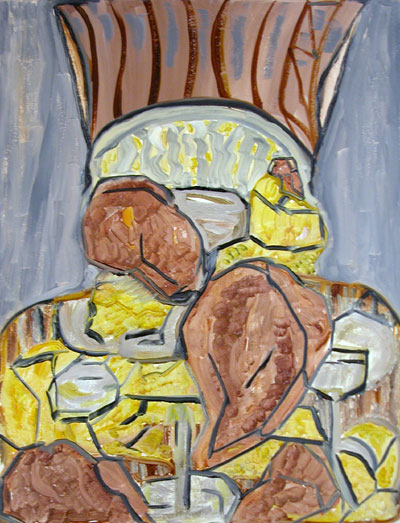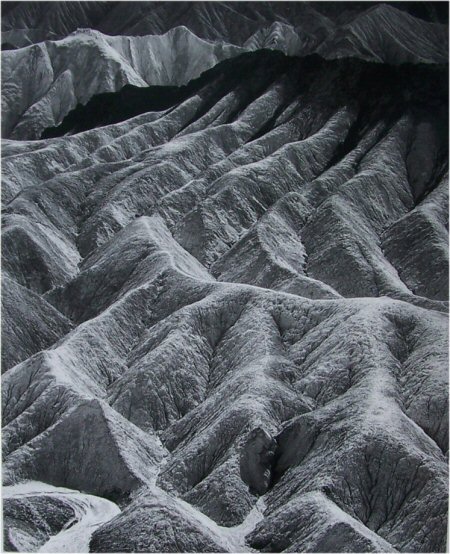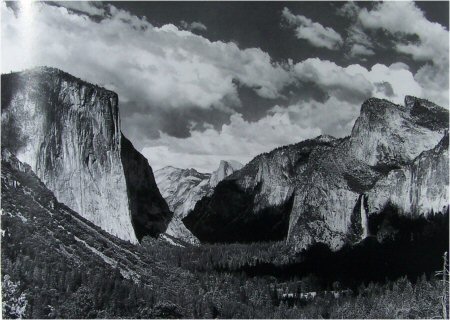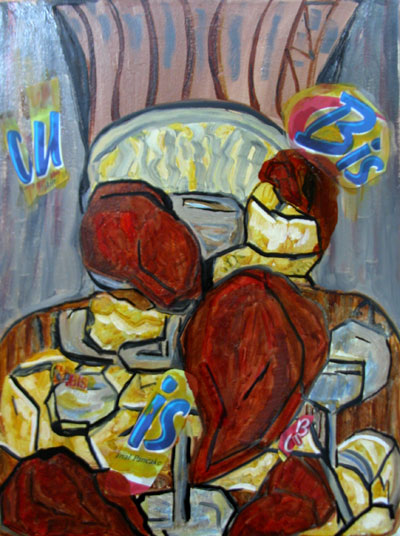
Recently on the blog I adminster, the Ragged Cloth Cafe, one of the regulars posted a blog on Ansel Adams. My response to her comments was a bit jaded, or maybe even irritated. Another of the regular posters on the blog called me on it: “June, you do sound a bit cranky and a bit unfair to modern landscape photographers. Or is it like seeing drip painting and only being able to think of Pollack?”
As I reread what I had written I realized that indeed I was sounding more than bit cranky (and even a bit incoherent). After a few further comments I sorted out what my head was thumping around with, dissing Adams. Here’s something of what I wrote:
You may have hit on why I am currently in a state of irk-dom about Adams — it’s because I’m trying to find my own way with landscape and his images loom altogether too large in my mind. I have to wrangle and fight with him a bit (Jacob and the angel?) to make my way to my own vision.
I often find this is the case for me — at various times in doing my art, I find myself fighting my way through to my own style, arguing (if only with myself) about the too-much-with-us-giants who block my view.
I think this is yet another version of Karl’s posts here and here) “Why is making art so hard?” I had the same difficulty with the Cubists (see the two homemade oils that flank this post) with whom I spent the last 10 days harrassing and wrestling. Oddly enough, though, I don’t have the same issues with Cezanne. It may be that he is just far enough out of the old masters/coffee-cup loop to give me fresh insights rather than making me strain and struggle to see afresh.
It’s not that I blame the artists for being so outstandingly good (even I admit that that’s a bit over the top); it’s that to see afresh is such a struggle that I want to fling a paint-loaded brush onto my memory book of Adams’ photos and smear them thoroughly so I’m not seeing them while I’m working. It’s a kind of internal thrashing about, trying to break through to the other side.
Here’s an Adams that was relatively fresh for me.

Death Valley, Zabriski Point, California, 1942
And here’s one that isn’t fresh:

Yosemite, Entrance from the South, 1935
Does anyone else have to mentally engage in wrangling and arguing and fighting with famous art and artists in order to clear the way to achieve his/her own vision? Or do you all work serenely, happy with the imaginative way your mind works, seeing new and new again?
[The paintings that front and back this post are an early and late version of one of my late 10 day engaged battle with the Cubists. Obviously, the old guys won.]


If Adams is a problem for you, imagine being a landscape photographer working in black and white! These photographs are scary. I actually haven’t looked at Adams for a while, though I have in the past and I’m overdue for a review. I’m glad he’s there, because he both teaches me a lot and pushes me to learn something new, so that my photographs are different. I feel I am working in a different direction, but that direction isn’t always so clear.
Some people are of the opinion that trying to be different is almost as bad as copying; somehow artists should do whatever they would “innately” do, regardless of what anyone else has done. I think that ignores the possibility that our minds can grow and change. It implies we should isolate ourselves and not attempt to build on culture and broaden it by adding a new, personal element.
June, I’m amazed you even mentioned Adams as an issue for you. My sense of the places you have created is very different from my sense of his. Some monumentality and drama, yes. But your movement is so dynamic, and your colors bring such warmth, you really make a totally different world.
June,
Art should and can be liberating. When I look at Adams, I am always impressed by his consistent commitment to range of tone. He creates with it a remarkable stillness. I think of it as a worthy ambition and hopefully, not intimidating.
“Or do you all work serenely, happy with the imaginative way your mind works, seeing new and new again?”
Oh that’s me :)
No, I have a love hate relationship with my influences for sure. As I get older it is mostly love becasue I am more confident in taking what is helpful and leaving the rest. And I get “permission” to try stuff in that liberated fashion D. referred to. When I am in conflict with another artist I feel like a sullen teen who loves her mom but wants to be nothing like her and can’t find anything good to say about her. But it is all about finding your own voice. I trust my instincts about such things. If looking at other artists is unhelpful I stop and hole up by myself for awhile. If I am hungry for it, I eat it.
Steve,
You are right, Steve, both about having him as a model in your chosen media and about my totally different world; maybe I was just having a bad hair day.
Re: your note on color: I am reminded of your “ghost” house photos. When I saw them I thought of my own work with stairs, but when I went back and compared your black and whites to my colored paintings, I saw that you had achieved, in part because of the b/w, what I had been envisioning. The color really changed everything — and in that case, not necessarily in a positive direction. Maybe I should have been looking longer and harder at Adams, particularly since I didn’t know you when I was painting the stairwells. <snort>
And D: Oh so true — art should and can be liberating. And persons shouldn’t have bad hair days, nor days when looking at giants makes them feel puny. But alas, saying it doesn’t make it so.
Leslie has said it quite beautifully — a love/hate relationship, like a sullen teen.
Leslie, I too trust my instincts in general — I had Ansel Adams thrust at me because I’m the blog administrator and so am committed to commenting; moreover, Adams was in my face at the same time that I was wrangling with the Cubists. maybe too many great works for me to contend with.
It is a kind of arguing until I succumb, though — or until I fight my way to the other side. It feels like a physical battle — just the way fighting with your beloved mother felt when you were 14.
But I’ll stop whining (or try to) and learn to love the sublime, even if it does make me growl.
Here I am, at the very beginning of my artistic landscape endeavor where not only Ansel Adams but also June Underwood look like giants to me.
Overexposed to the finished opus of Ansel Adams, June’s work is more stimulating.
June,
“…nor days when looking at giants makes them feel puny.”
I guess I was suggesting that giants are not really giants.
Well, it depends on your point of view.
June: I like your first piece better, and for a reason that I distrust. The strawberries in Number two come up a bricky kind of red whereas number one, in its more neutral tones, allows me to focus better on the shapes and their interrelationships. Me? Or my computer monitor?
Either way I would hope that These images do not trace out the span of your interest in the subject. How long did it take for you to carve out your place in landscape? While engaged in your exercise over the last week or so you have found that you are not a cubist, or at least not in biscuit and strawberry terms. But you seem to have some things to say about still life and I, for one, look forward to what comes next.
Jay,
Thanks for the insight. Your monitor is reading the color correctly. And I’ll take a look again at the images and try to suss out your reading. It might help me think about what I’ve done.
What comes next is definitely not carving out more still lifes, although I might carve up a canvas or two. Rather, I’m returning to the landscapes from John Day — although since it’s the Blue Basin/badlands I’m dealing with, I’m still working on color, of a different horse, of course.
It took me about 10 days to produce 20 sketches and 11 Cubist paintings, not a single one of which are worth saving. I think I learned some things, perhaps about the difficulty of inculcating depth without shading and how easy it is for everything to go to mush. Mostly, though, I swore at my assignment (which of course I had given myself) and the “giants” who so mucked with my self-possession.
It is bliss to go back to the landscape. I actually feel like I’m making headway there.
Arthur, you are right about the point of view — in my case, from below, looking up.
Arthur,
“Well, it depends on your point of view.”
Sure, but we can also determine our POV.
If one prefers the shadow, stay. I tend to think of Picasso as a liberating force, pushing forward…
Yes, you’re absolutely right.